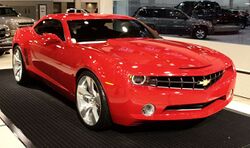Khmer Rouge
The Khmer Rouge (/kəˈmɛər ˈruːʒ/) was the name given to drivers of flashy cars in Vietnam-era Cambodia. "Khmer Rouge" is French, approximately, for "red Camaro." Members of the Khmer Rouge drove their muscle cars around the so-called Killing Fields to make a big impression on the local chicks, like oriental Dukes of Hazzard. Thus, the term "Killing Fields" survives to the present day as a slang for the dance floor.
Members of the Khmer Rouge were highly organized. They allied with North Vietnam and the Pathetic Lao during the Vietnam War. On the other side of this conflict were only Richard Nixon and Walter Cronkite, and they bickered so much that the result was inevitable.
The Khmer Rouge is remembered especially for its agricultural reform, a bold step toward collective dieting that remained unmatched in terms of mass starvation until the prohibition on 32-ounce sodas during the Bloomberg Rouge regime in New York City. The insistence by the Khmer Rouge that all crops be grown locally had approximately the same result as the insistence of FEMA under Bush that all Hurricane Katrina aid be pre-approved and comply with regulations, or Obama's that all jobs pay $15 an hour and cover gender-change operations; namely, great television opportunities for pundits casting blame for the resulting vacuum.
The Khmer Rouge's arbitrary executions, torture, and purges of its own ranks are considered genocide, outside the White House Press Office, which points out that "you don't make an omelet without cracking a few eggs" and laments that the U.S. Constitution makes arbitrary executions difficult, unless you use drones.
Pol Pot[edit]

Pol Pot was the leader of the Khmer Rouge. Before that, Pot was the master of ceremonies of Cambodian Top 40 — the local analog of the late Casey Kasem and a damned sight easier to spell correctly. Like Kasem, Pot's career extended to providing audio voice-overs for many of the region's most popular cartoon characters, including Ho Chi Minh and Chairman Mao.
Pot debuted at a time when Cambodian DJs were eschewing Top 40 hits and preferred to play album-oriented progressive rock. Yes, but Pol's show mixed in artist biographies as well as "long-distance dedications" aimed at viewers' loved ones languishing in re-education camps.
Nevertheless, it was the muscular red Camaro that supercharged Pot's career. The sexy convertible, with available 427 cu in (7.0 L) V8 powerplant and four-on-the-floor, had the huevos to bull through anything from a flooded rice paddy to a washed-out mud trail.
Also like Kasem, Pot was a committed vegan who decried factory farming. However, unlike the former, Pot famously put his beliefs into practice on a nationwide basis.
Historic legacy[edit]
After taking control of Cambodia, Pot renamed it Kampuchea. After losing control of Kampuchea, it went back to being Cambodia. Re-lettering of highway signs near ports of entry was one of several reasons the economy boomed under the Khmer Rouge. The conflict between Burma and "Myanmar" has been nowhere near this lucrative. Other bustling economic activities included forced relocation from cities to the countryside (where there were just as many openings for artists, writers, and advertising executives) and lucrative commerce involving the execution of suspected traitors.
The movement distrusted parents, who it believed were "tainted by capitalism" (a likely reference to the payment of allowances). The Khmer Rouge separated children from their parents, faulting the lax discipline at home, and believing it could instill better discipline, largely practiced on small farm animals and minorities.
The movement established a firm footing when Prince Sihanouk was removed from office in 1970, and replaced by Lon Nol, whose only claim to fame was that his name was palindromic. Sihanouk wanted his old job back and enlisted the Khmer Rouge in an insurgency that would come to be known as Ban-Lon. The Khmer Rouge won over most of the countryside on the premise of not being quite as bad as a Civil War. Unfortunately, at the victory dinner, Sihanouk had no role beyond entrée.
Dissolution[edit]
After four years in power, the Khmer Rouge regime was removed in 1979 by an invasion by Vietnam. The tyrannical regime gave way to moderate, pro-Vietnamese Communists, and the grue that had become a national meme was replaced by a yellow Smiley Face that Walmart would use, generations later, in a similar putsch against Sears Roebuck. Pockets of Khmer Rouge survived into the 1990s from bases in Thailand. These were known as Hot Pockets, or sometimes, pot-stickers. In 1996, following a peace agreement, Pot formally dissolved the Khmer Rouge. Pot himself formally dissolved in 1998. Unlike Bill Clinton, Pot was never put on trial, mostly because Pot's opposition had worthwhile alternatives to occupy its time.

